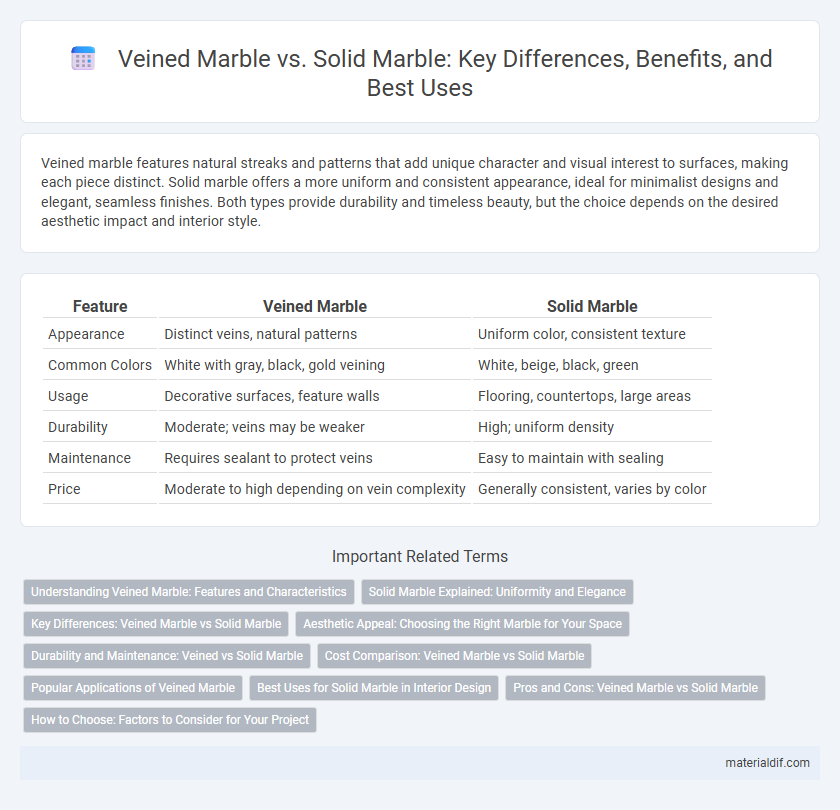Veined marble features natural streaks and patterns that add unique character and visual interest to surfaces, making each piece distinct. Solid marble offers a more uniform and consistent appearance, ideal for minimalist designs and elegant, seamless finishes. Both types provide durability and timeless beauty, but the choice depends on the desired aesthetic impact and interior style.
Table of Comparison
| Feature | Veined Marble | Solid Marble |
|---|---|---|
| Appearance | Distinct veins, natural patterns | Uniform color, consistent texture |
| Common Colors | White with gray, black, gold veining | White, beige, black, green |
| Usage | Decorative surfaces, feature walls | Flooring, countertops, large areas |
| Durability | Moderate; veins may be weaker | High; uniform density |
| Maintenance | Requires sealant to protect veins | Easy to maintain with sealing |
| Price | Moderate to high depending on vein complexity | Generally consistent, varies by color |
Understanding Veined Marble: Features and Characteristics
Veined marble displays intricate patterns created by mineral impurities, giving each slab a unique, natural design that enhances aesthetic appeal in interiors. These veins vary in color and thickness, often forming striking contrasts that highlight the stone's depth and texture. Solid marble, in contrast, presents a uniform color and minimal patterning, offering a more consistent and subtle look.
Solid Marble Explained: Uniformity and Elegance
Solid marble is characterized by its uniform color and consistent texture, offering a sleek and elegant appearance that complements minimalist and modern design aesthetics. Unlike veined marble, which showcases natural streaks and patterns, solid marble provides a smooth, uninterrupted surface ideal for creating a timeless and sophisticated look in interior spaces. Its homogeneity enhances visual calmness and allows greater versatility in coordinating with various color palettes and decorative elements.
Key Differences: Veined Marble vs Solid Marble
Veined marble features distinct natural patterns with intricate lines and swirls caused by mineral impurities, offering a dynamic and textured appearance. Solid marble has a consistent color and uniform texture throughout, providing a clean and minimalist aesthetic ideal for modern designs. The key differences impact durability, maintenance, and visual appeal, with veined marble showcasing unique character, while solid marble emphasizes simplicity and elegance.
Aesthetic Appeal: Choosing the Right Marble for Your Space
Veined marble features natural patterns and intricate streaks that create a dynamic, luxurious aesthetic, ideal for adding character and elegance to any space. Solid marble offers a more uniform and consistent appearance, providing a clean and minimalist look that complements modern or understated designs. Selecting between veined and solid marble depends on the desired visual impact and the overall style intended for your interior or architectural project.
Durability and Maintenance: Veined vs Solid Marble
Veined marble features natural patterns created by mineral impurities, which can sometimes mask minor wear and staining, making maintenance slightly easier compared to solid marble. Solid marble, with its uniform color and appearance, tends to show scratches and stains more visibly, requiring more frequent sealing and careful upkeep to preserve its durability. Both types need regular maintenance, but veined marble's natural patterning can be advantageous in hiding imperfections over time.
Cost Comparison: Veined Marble vs Solid Marble
Veined marble typically commands a higher price than solid marble due to its intricate patterns and natural variations, which require more careful quarrying and selection. Solid marble, with its uniform color and texture, is generally more affordable and easier to source in larger slabs. The cost difference also depends on factors such as origin, thickness, and finish, but veined marble's unique aesthetic often justifies its premium pricing in luxury interior applications.
Popular Applications of Veined Marble
Veined marble is widely favored in interior design for its distinctive, natural patterns that enhance luxury spaces such as countertops, flooring, and wall cladding. Its unique veining makes it ideal for statement pieces in bathrooms and kitchens, where aesthetics are paramount. Architects and designers often select veined marble for decorative accents and feature walls to create visually striking environments.
Best Uses for Solid Marble in Interior Design
Solid marble, characterized by its uniform color and smooth texture, is ideal for minimalist interior design schemes that emphasize clean lines and subtle elegance. Its consistent appearance makes it perfect for large surface applications such as kitchen countertops, bathroom vanities, and flooring where a sleek, timeless look is desired. Designers often choose solid marble to create visual calm and balance, enhancing the overall sophistication of contemporary and modern spaces.
Pros and Cons: Veined Marble vs Solid Marble
Veined marble offers unique patterns and natural elegance, enhancing aesthetic appeal but may require more maintenance due to visible veins that can show stains or scratches. Solid marble provides a consistent color and smooth surface ideal for minimalist designs with easier repairability, yet it can appear less dynamic and more uniform compared to veined varieties. Choosing between veined and solid marble depends on desired visual impact, maintenance willingness, and the specific application's durability needs.
How to Choose: Factors to Consider for Your Project
When choosing between veined marble and solid marble for your project, consider the overall design style and desired visual impact; veined marble offers intricate patterns that create a dynamic focal point, while solid marble provides a uniform, minimalist aesthetic. Assess the project's lighting conditions, as veined marble interacts with light differently, enhancing textures, whereas solid marble reflects light evenly, emphasizing simplicity. Also evaluate maintenance requirements and durability, since veined marble may reveal stains more easily compared to the consistent surface of solid marble.
Veined marble vs Solid marble Infographic

 materialdif.com
materialdif.com